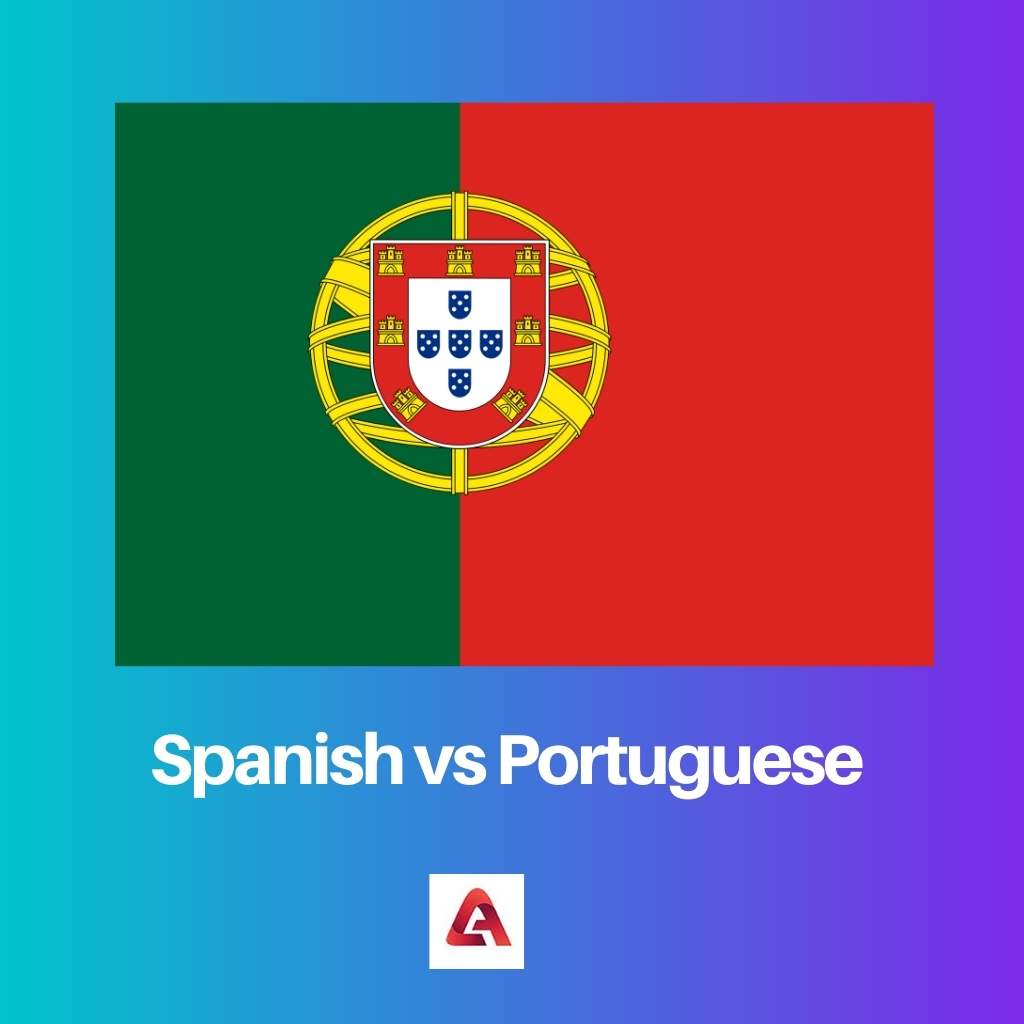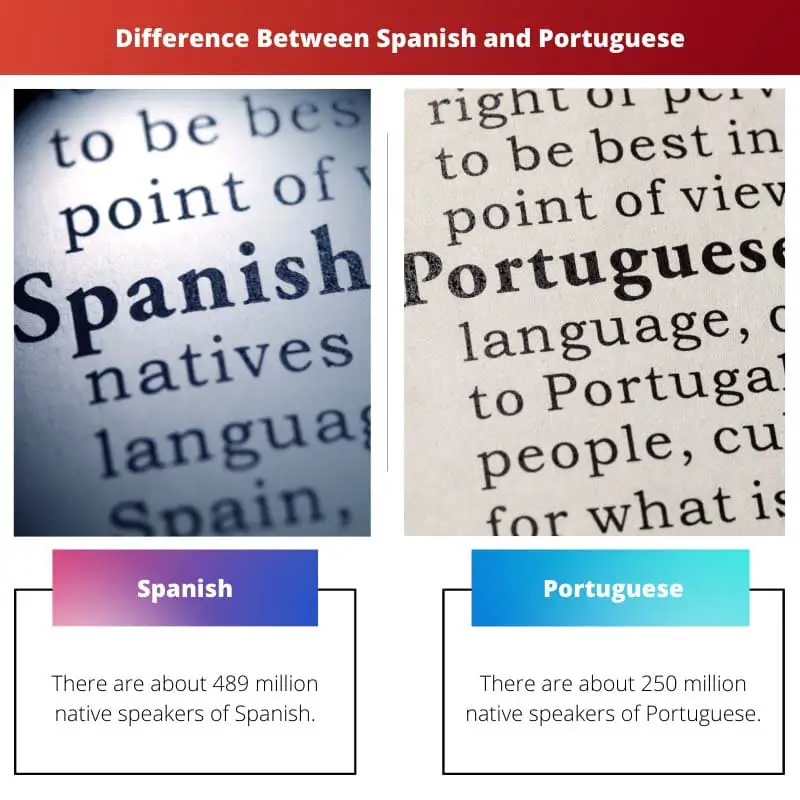Spanish and Portuguese are the two most widely spoken languages in the world. Both languages fall under the branch of Romance Languages.
Also, both languages originated from the Indo-European languages. Both Spanish and Portuguese have multiple variants and dialects that are easily understood by the people who fall under this branch.
Even though there are many similarities between both languages but at the same time, there are some distinct differences between them.
Key Takeaways
- Spanish and Portuguese are both Romance languages derived from Latin.
- Spanish is spoken in Spain and throughout Latin America, whereas Portuguese is spoken in Portugal, Brazil, and some parts of Africa.
- Portuguese pronunciation has a softer and more nasal sound than Spanish, and Portuguese has more complex grammar and verb tenses than Spanish.
Spanish vs Portuguese
Spanish is a Romance language that evolved from Latin and is spoken mainly in Spain, as well as many countries in Latin America. It is the second-most spoken language in the world. Portuguese is a Romance language which evolved from Latin and is spoken in Portugal, Brazil, Angola, etc.

Spanish is regarded as the world’s 2nd most-spoken indigenous language, in respect of people who speak it as their first language. There are approximately 489 million native speakers of Spanish.
Spanish is considered the official language of about 20 countries all over the world. Also, in around 79 countries, we can find Spanish Speakers. The written script of Spanish is in Latin.
On the other hand, Portuguese also belongs to the branch of the Romance languages. There are about 250 million indigenous speakers of Portuguese.
The Portuguese language also originates from the Indo-European family. It is considered the official language of about 9 countries. Also, it is ranked as the sixth most-spoken language in the world.
Comparison Table
| Parameters of Comparison | Spanish | Portuguese |
|---|---|---|
| Native Speakers | There are about 489 million native speakers of Spanish. | There are about 250 million native speakers of Portuguese. |
| Official language | In 20 countries Spanish is considered the official language. | In 9 countries Portuguese is considered the official language. |
| Ranking of language | Spanish ranks second position as the world’s most-spoken indigenous language. | Portuguese ranks sixth position as the world’s most-spoken indigenous language. |
| Alphabets | There are about 27 letters in the Spanish alphabet. | There are about 23 letters in the Portuguese alphabet. |
| Learning Process | The learning process of Spanish is easier. | The learning process of Portuguese is a bit harder as compared to Spanish. |
What is Spanish?
Spanish is a language that belongs to the branch of Romance languages. It is derived from the Indo-European languages.
During the beginning of the 11th century, the dictionary of the Spanish language was enhanced with some French words and expressions by some priests and pilgrims. It has a lot of influence from both Latin and Arabic languages.
Also it is a widely spoken language and also the national language of twenty countries. It is one of the main official languages of the United Nations. In about twenty countries, Spanish is considered the official language of the respective countries.
These countries include Argentina, Bolivia, Chile, Colombia, Costa Rica, Cuba, Dominican Republic, Ecuador, El Salvador, Equatorial Guinea, Guatemala, Honduras, Mexico, Nicaragua, Panama, Paraguay, Peru, Spain, Uruguay, and Venezuela.
Also, Spanish is spoken in other countries as well. The writings or the Script of the Spanish language are written in Latin. More speakers speak Spanish as their first language as well as a foreign language.
The Spanish language is comprised of 27 letters. Generally, Spanish is considered easy to learn as compared to Portuguese.
But at the same time, if a person knows any of these languages, it becomes easier to learn both languages as they are almost the same.

What is Portuguese?
Portuguese is a language that belongs to Portugal. The Portuguese language is also considered one of the most popular languages in the world.
It, too, has many speakers but comparatively lesser than Spanish speakers. It is considered the sixth most indigenous language in the world.
It also belongs to the branch of the Romance Language. And it originated from the Indo-European languages. About 250 million native speakers of Portuguese can be found.
It is a widely spoken European language after Spanish. In about nine countries, Portuguese is considered the official language of the respective countries.
These countries include Angola, Brazil, Cape Verde, Timor Leste, Equatorial Guinea, Guinea-Bissau, Mozambique, Portugal, and Sao Tome and Principle.
The Portuguese language is also spoken in different parts of the world, but there, it is not counted as an official language.
The main difference between Spanish and Portuguese is the pronunciation, grammar, etc, of their respective words. The writings of the Portuguese language are also written in the Latin language.
The Portuguese alphabet is comprised of 23 letters. The difference between the Spanish and Portuguese languages is about four alphabets. The term alphabet is pronounced as alfabeto. The letters that have been missing are K, W, and Y.

Main Differences Between Spanish and Portuguese
- There are about 489 million native speakers of the Spanish language. On the other hand, there are about 250 million native speakers of the Portuguese language.
- In 20 countries, Spanish is considered the official language. On the other hand, in 9 countries, Portuguese is considered the official language.
- Spanish ranks second position as the world’s most-spoken language. On the other hand, Portuguese ranks sixth position as the world’s most-spoken language.
- There are about 27 alphabets in Spanish. On the other hand, there are about 23 alphabets in Portuguese.
- The learning process of Spanish is easier. On the other hand, the learning process of Portuguese is a bit harder as compared to Spanish.

- https://www.google.com/books?hl=en&lr=&id=aPcQY1CeW4IC&oi=fnd&pg=PR5&dq=spanish+vs+portuguese&ots=xNty4KMsD9&sig=-GwOJX3gM-_SiRVasS5qgIOLhHQ
- https://www.google.com/books?hl=en&lr=&id=ausuAAAAYAAJ&oi=fnd&pg=PP14&dq=spanish+vs+portuguese&ots=H07-ELQpMj&sig=JmBN0kCHu2d6K4e2Iwh880HgYFE

The profound influence of Spanish and Portuguese on various continents underscores the significance of Romance languages in shaping global communication. The enduring legacies of these languages continue to impact diverse communities, fostering intercultural exchange and understanding.
Absolutely, the enduring legacy of Romance languages exemplifies the interconnected nature of societies and the indelible mark left by language on the world.
The intercultural exchange facilitated by Spanish and Portuguese demonstrates the vital role of language in bridging diverse communities and fostering mutual understanding.
I find it interesting to note that Spanish is considered the second most-spoken indigenous language in the world while Portuguese is ranked in sixth place, despite both languages being Romance languages derived from Latin. The wide gap between the number of native speakers indicates that Spanish may be more accessible to people worldwide.
I would have to agree with you on that. The popularity of Spanish in so many countries makes it much more in-demand than Portuguese.
Without a doubt, the prevalence of Spanish across many continents truly highlights its significant linguistic influence.
It’s intriguing how the Spanish alphabet consists of 27 letters compared to the Portuguese alphabet, which only has 23 letters. This discrepancy reflects the differences in linguistic structure that may explain the easier learning process for Spanish.
It’s astonishing to consider how just a few letters can impact the overall language learning experience. The contrast in alphabets adds depth to understanding Spanish and Portuguese.
Definitely a fascinating observation. The uniqueness of the alphabets provides an interesting insight into the distinct characteristics of the languages.
The intricate nuances and historical evolution of Spanish and Portuguese as Romance languages epitomize the rich diversity of human communication. The ever-evolving linguistic tapestry shaped by these languages continues to captivate and inspire exploration into the multifaceted nature of human expression.
The captivating historical evolution and enduring relevance of Spanish and Portuguese elucidate the intricate web of human communication, underscoring the dynamic interplay of language in shaping our shared narrative.
Indeed, the ever-evolving nature of Spanish and Portuguese as linguistic entities weaves a captivating narrative of the human experience, illuminating the profound impact of language on cultural expression and understanding.
Despite the difficulty of learning Portuguese compared to Spanish, the rich history and depth of the Portuguese language contribute to its distinct charm and allure. The complexities of Portuguese may present an exciting linguistic challenge for those eager to explore its unique intricacies.
The complexity of Portuguese adds a layer of depth to the language that is truly captivating. The challenge of mastering Portuguese may lead to a gratifying linguistic achievement.
I couldn’t agree more. The intricacies and nuances of Portuguese offer a captivating journey into the world of language, making it a rewarding pursuit for language enthusiasts.
The dynamic relationship between Spanish and Portuguese, characterized by shared origins and distinct differences, offers a compelling study in comparative linguistics. Exploring these languages unveils a rich tapestry of historical, cultural, and linguistic interplay that continues to shape our global linguistic landscape.
Indeed, the intricate interplay of historical, cultural, and linguistic elements in Spanish and Portuguese provides a fascinating lens through which to understand the diverse tapestry of human communication.
The geographical prevalence of Spanish as the official language in 20 countries compared to Portuguese in 9 countries sheds light on the vast differences in global linguistic influence. The extensive use of Spanish across different regions highlights its profound impact on diverse cultures and societies.
It’s truly remarkable to see how Spanish has established itself as a critical means of communication in numerous nations, influencing various aspects of life and culture.
The enduring relevance of Spanish and Portuguese as prominent global languages reflects their profound significance in connecting diverse populations across continents. The continued impact of these languages underscores the timeless nature of linguistic influence in shaping human interaction and understanding.
The timeless significance of Spanish and Portuguese highlights the pervasive influence of language in transcending geographical, cultural, and temporal boundaries.
Absolutely, the enduring relevance of Spanish and Portuguese testifies to the enduring power of language in fostering global connections and cultural exchange.